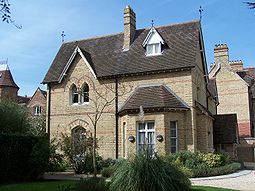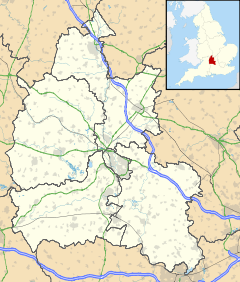- North Oxford
-
Coordinates: 51°46′26″N 1°15′58″W / 51.774°N 1.266°W
North Oxford
Park Town, one of central North Oxford's earliest Victorian suburban developments
 North Oxford shown within Oxfordshire
North Oxford shown within OxfordshireOS grid reference SP509079 Parish unparished District Oxford Shire county Oxfordshire Region South East Country England Sovereign state United Kingdom Post town Oxford Postcode district OX2 Dialling code 01865 Police Thames Valley Fire Oxfordshire Ambulance South Central EU Parliament South East England UK Parliament Oxford West and Abingdon Website Oxford City Council List of places: UK • England • Oxfordshire  37 Banbury Road, St Anne's College, a typical North Oxford Gothic house
37 Banbury Road, St Anne's College, a typical North Oxford Gothic house
 The former residence of the Victorian lexicographer James Murray, first editor of the Oxford English Dictionary, at 78 Banbury Road
The former residence of the Victorian lexicographer James Murray, first editor of the Oxford English Dictionary, at 78 Banbury Road
North Oxford is a suburban part of the city of Oxford in England. It was owned for many centuries largely by St John's College, Oxford and many of the area's Victorian houses were initially sold on leasehold by the College.
The leafy roads of Woodstock Road to the west and Banbury Road to the east (leading to Woodstock and Banbury respectively) run north-south through the area, meeting at their southern ends to become St Giles' Street. North Oxford is noted for its schools, especially its private schools. These include the Dragon School and Summer Fields (formerly Summerfield), which are preparatory schools, and St Edward's School and the Oxford High School for Girls, which are secondary schools.
Contents
Geography
Four of Oxford University's former women's colleges, Lady Margaret Hall, St Anne's, St Hugh's and Somerville (at the southern extreme) are located in North Oxford. There are also four graduate colleges, Green College, St Antony's, both off the Woodstock Road, Kellogg on Banbury Road, and to the east Wolfson, on the River Cherwell. Further south, also bordering the Cherwell, are the University Parks. A large open area of ancient common land, Port Meadow, adjoining the River Thames, is located to the west.
Much of the central area contains excellent examples of late 19th century Victorian Gothic architecture, and is now a conservation area. There are Regency-style houses built in the mid-19th century in the crescents of Park Town, initially in the middle of the countryside but now surrounded by the rest of the suburb.
Central North Oxford between the city centre and Summertown, has been described as the most desirable suburb of Oxford, England.[1][2][3] It is popularly supposed that it was originally developed for the dons of the University once they were allowed to marry. However central North Oxford in particular includes many large houses which were then unaffordable by most dons, and the houses were instead occupied by successful tradesmen of the city. Today, many homes are occupied by rich London commuters, attracted by the good schools. A number of the larger houses are used by Oxford colleges and other educational establishments.
At the northern extremity of North Oxford, which is approximately the line of the A40 (the northern bypass, part of the Oxford ring road) are three suburbs, Sunnymead and Cutteslowe (to the east of Banbury Road) and Wolvercote to the west of Woodstock Road. Beyond the bypass is the village of Kidlington. Wolvercote Cemetery contains the grave of J. R. R. Tolkien (note that Wolvercote Cemetery is not in Wolvercote itself, but beside Banbury Road north of the A40). Cutteslowe Park is a large open area just to the north of this bypass.
Notable people
North Oxford has attracted famous residents, such as the authors and academics J. R. R. Tolkien (1892–1973) and Iris Murdoch (1919–1999). Murdoch lived with her husband and fellow academic John Bayley, and the area was featured in the biographical film, Iris. T. E. Lawrence (known as Lawrence of Arabia) grew up in Polstead Road, North Oxford. Jeremy Clarkson of the BBC TV Series Top Gear is also resident in North Oxford.
Sir John Betjeman (1906–1984), Poet Laureate, was an enthusiast about North Oxford and wrote poems mentioning the area, such as May-Day Song for North Oxford:
Belbroughton Road is bonny, and pinkly bursts the spray
Of prunus and forsythia across the public way,
For a full spring-tide of blossom seethed and departed hence,
Leaving land-locked pools of jonquils by sunny garden fence.
And a constant sound of flushing runneth from windows whence
The toothbrush too is airing in this new North Oxford air.See also
- Norham Manor
- Walton Manor
- Acland Hospital
- Cherwell Boathouse
- Oxford Ecohouse
- St Philip and St James Church
References
Sources and further reading
- Crossley, Alan; Elrington, C. R. (eds.); Eleanor Chance, et al. (1979). Victoria County History: A History of the County of Oxford, Volume 4.
- Curl, James Stevens (1977). The Erosion of Oxford. Oxford Illustrated Press Ltd. ISBN 0-902280-40-6.
- Hinchcliffe, Tanis (1992). North Oxford. New Haven: Yale University Press. ISBN 0-300-05184-0.
- Sherwood, Jennifer; Pevsner, Nikolaus (1974). The Buildings of England: Oxfordshire. Harmondsworth: Penguin Books. ISBN 0 14 071045 0.
- Snow, Peter (1991). Oxford Observed. London: John Murray (Publishers). pp. 157–173. ISBN 0-7195-4707-5.
- Tyack, Geoffrey (1998). Oxford: an architectural guide. Oxford & New York: Oxford University Press. ISBN 0-19-817423-3.
External links
Categories:- Districts of Oxford
- St John's College, Oxford
Wikimedia Foundation. 2010.





